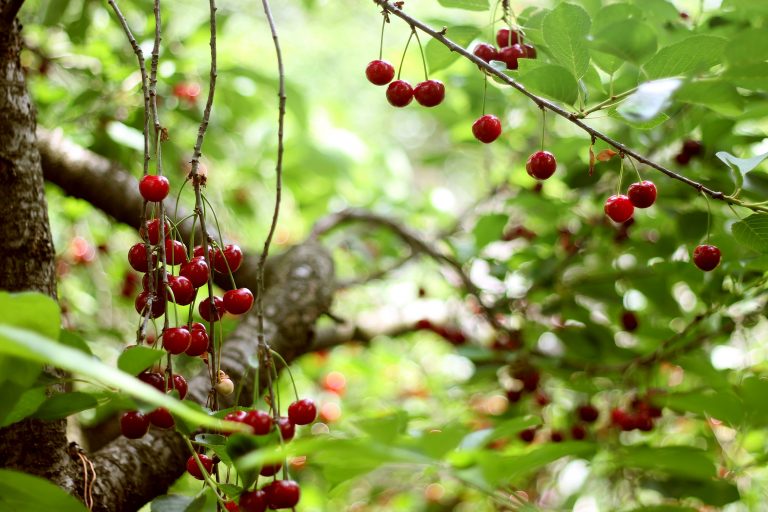Cherry trees are known for their beautiful blossoms in spring and their sweet, juicy fruit in summer. However, some gardeners notice the leaves on their cherry trees turning red during the summer months. This can be alarming if you’re not expecting it.
Red leaves on a cherry tree in summer are often a sign of environmental stress. With the proper care and corrections the tree can recover and regain its normal green foliage. Understanding the various causes of red summer leaves will help you get your cherry tree back to health.
Main Causes of Red Cherry Tree Leaves in Summer
There are 5 key reasons why cherry tree leaves may become red and discolored during summer
1. Leaf Scorch
Leaf scorch occurs during hot, dry weather when the tree loses moisture faster than the roots can absorb it. The leaves dry out and the edges or tips turn brown or red. Cherry trees are especially prone to leaf scorch when they’re young or newly transplanted.
2. Nutrient Deficiencies
Lack of important nutrients like nitrogen, iron, and magnesium leads to red pigments called anthocyanins building up in the leaves. This gives them a red discoloration rather than green. Insufficient soil nutrition is a very common cause of red summer leaves.
3. Root Problems
Issues with the roots like compaction, damage, disease, or restricted growth can prevent proper uptake of water and nutrients. The resulting stress on the tree may cause red leaves.
4. Environmental Stresses
Dramatic shifts in weather, pest infestations, diseases, and other environmental factors can stress the cherry tree. Its physiology gets disrupted, potentially leading to red leaves.
5. Old Leaf Age
Older leaves that have been on the tree since spring will naturally turn red and drop off in mid-summer. As long as new growth is still green, this leaf drop is normal.
How to Care for Cherry Trees with Red Summer Leaves
If your cherry tree has developed red leaves, take these corrective steps tailored to the likely cause:
- Check soil moisture and water deeply if dry
- Apply organic mulch to retain moisture
- Fertilize to provide missing nutrients
- Examine roots and remedy compaction or damage
- Prune dead branches which waste energy
- Eliminate pest infestations like aphids
- Test and amend soil pH if needed
- Remove weak shoots to focus growth
- Monitor for new green leaf growth
It can take weeks or months for the leaves to turn fully green again. Seek expert help if problems persist or the tree declines further.
Signs of a Dying Cherry Tree
While summer red leaves are usually not fatal, a cherry tree with severe decline may be dying from an irreversible problem. Symptoms that indicate possible mortality include:
- Leaves wilting and falling off in large quantities
- Extensive branch dieback from the outer tips
- Splitting or peeling bark on trunk
- Fungal growths at tree base
- Oozing sap or sticky residues on bark
- Lack of any new growth or leaf buds
A qualified arborist should inspect cherry trees exhibiting major decline before it’s too late. Rapid diagnosis and treatment may save some trees.
Normal Red-Leafed Cherry Tree Varieties
Some ornamental cherry trees are prized for their natural red-hued foliage, including:
- Kwanzan – Purple-red leaves turning bronze in fall
- Royal Burgundy – Deep purple leaves all season
- Okame – Young leaves emerge pink before turning green
- Akebono – Reddish-purple tinted leaves
- Yoshino – Red-tinged leaves
These weeping cherries also have trademark reddish leaves:
- Snow Fountains – Bronze-red cascading leaves
- Amanogawa – Foliage turns red-orange in fall
So certain red summer leaves are perfectly normal on these ornamental varieties. It’s when green-leafed fruiting or flowering cherries show red that problems may exist.
The Takeaway
- Summer red leaves on a cherry tree are often caused by stresses like drought, heat, or pests.
- Nutrient deficiencies and other cultural issues can also turn leaves red.
- With prompt diagnosis and care, the tree should recover and produce new green growth.
- Varieties like Kwanzan cherry naturally have red-hued leaves.
- Severe leaf drop, branch dieback, oozing, and fungal growths may mean the tree is dying.
- Professional diagnosis helps identify factors damaging cherry trees.
- Addressing red leaves early allows the best chance to restore the tree’s health.
In most cases, red summer leaves are just a temporary issue for cherry trees. A bit of TLC tailored to the underlying problem will get your cherry tree thriving again soon!

How to Prune a Cherry Tree
FAQ
Why are my cherry tree leaves turning red?
Cherry leaf scorch and leaf spot are diseases of Prunus spp. caused by the pathogenic fungi Apiognomonia erythrostoma and Blumeriella jaapii.
What causes leaves to turn red in summer?
The freshly grown leaves are red due to high concentrations of a group of pigments called anthocyanins. These pigments provide several benefits to developing leaves. First, they act as sunscreen, helping the new leaves handle heavy exposure to summer’s direct sunlight.
What does it mean when tree leaves turn red?
Darker red leaves are the result of a chemical change: Sugars that can get trapped in the leaves produce new pigments (called anthocyanins) that weren’t part …Sep 21, 2021
What does an overwatered cherry tree look like?
If you are overwatering your trees, the leaves may be a bit gummy or wilted, though they will still be brown. This is a harder problem to solve, because these leaves may not fall off the tree. Unfortunately, many people try to fix this problem by doing the exact opposite.
